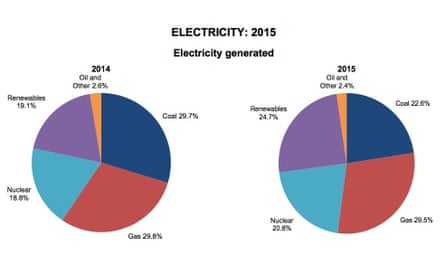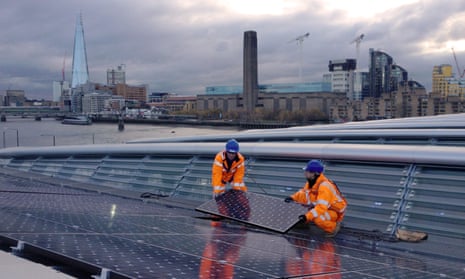Plummeting coal use in 2015 led to a fall of 4% in the UK’s annual carbon dioxide emissions, according to government energy statistics published on Thursday. Coal is now burning at its lowest level in at least 150 years.
The closing of old polluting coal-power stations and the rapid rise in renewable energy meant coal consumption fell by 22% compared to 2014, the biggest drop ever seen outside of miners’ strikes, according to analysts at Carbon Brief. Production of coal in the UK also fell to a new record low, dropping by 27% due to mines closing.
The rapid decline in coal use is continuing in 2016, with four more stations closed in the last fortnight, including Longannet, Ferrybridge and Eggborough, leaving six operational. The government has pledged to close all coal plants by 2025 to help meet climate change targets.
The future of the large new nuclear plant at Hinkley Point in Somerset is also in serious doubt, leading to concerns about energy security.
But experts said coal plant closures would not lead to the lights going out. “We have seen at least five years of “lights out” headlines, so far without so much as a flicker caused by insufficient capacity,” said Prof Michael Grubb, at University College London. “Despite tight margins, extreme weather is far more likely to cause any household disconnections than insufficient generating capacity.”
“Closure of these coal plants is both expected and necessary,” said Jonathan Gaventa, director of thinktank E3G. “The UK has plenty of options to cover the loss of coal-fired power through energy efficiency, renewables, interconnection with other countries and smart demand. This combination can deliver low-cost electricity reliably and quickly.”
Renewable electricity generation surged in 2015, rising by 29%, allowing it to claim a record 25% share of all electricity. Most of this came from wind power and bioenergy, the latter being boosted by the continued conversion of Drax - once the UK’s biggest coal plant - to burning wood pellets.

Solar power increased by 50% in 2015 to make up 9% of all renewable electricity. The government has been repeatedly criticised for cutting support for renewable energy and energy efficiency programmes.
“If anything is to blame for tight margins, it’s previous governments’ history of incoherent energy policy,” said Paul Massara, former CEO of “big six” energy company RWE npower. “Investors need long-term clarity on policy, and they simply have not been getting it.”
“Look outside the UK and it’s clear that the direction of travel in is only in one direction, towards primarily low-carbon, flexible, smart energy systems,” said Andrew Garrad, senior consultant at DNV GL energy. “It’s been accelerated by the Paris climate agreement, and Britain is by no means ahead of the pack in this transition.”
The share of electricity generated by gas remained unchanged at 30% while nuclear’s share rose by two percentage points to 21%. The energy used by transport rose, which the government said was probably due to lower petrol prices.
Oil production in the UK was 13% higher than in 2014 and gas production 8% higher, both bucking the trend of steady decline seen since the peaks seen in 1999 and 2000 respectively. The UK is the only G7 country increasing fossil fuel subsidies, according to a report in November.

Comments (…)
Sign in or create your Guardian account to join the discussion